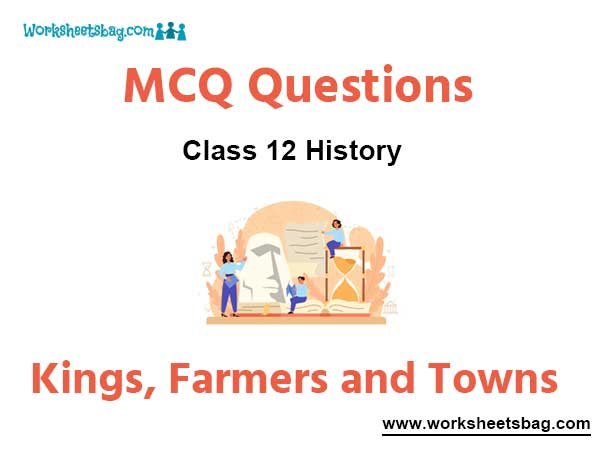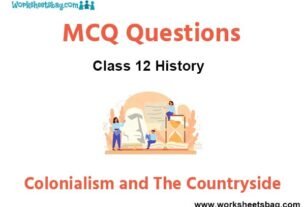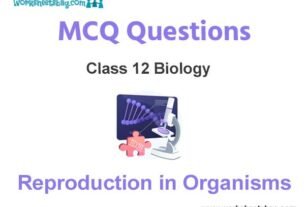Please refer to Kings, Farmers and Towns MCQ Questions Class 12 History below. These MCQ questions for Class 12 History with answers have been designed as per the latest NCERT, CBSE books, and syllabus issued for the current academic year. These objective questions for Kings, Farmers and Towns will help you to prepare for the exams and get more marks.
Kings, Farmers and Towns MCQ Questions Class 12 History
Please see solved MCQ Questions for Kings, Farmers and Towns in Class 12 History. All questions and answers have been prepared by expert faculty of standard 12 based on the latest examination guidelines.
MCQ Questions Class 12 History Bricks, Beads and Bones
Question. James Prinsep was able to decipher Asokan Brahmiin the year
(A) 1835
(B) 1838
(C) 1856
(D) 1738
Answer
B
Question. Scholars in the late nineteenth and early twentieth centuries were primarily interested in the histories of:
(A) kings
(B) travellers
(C) inventions
(D) None of the Above
Answer
A
Question. Scholars from the mid-twentieth century onwards, were primarily interested in the histories of …………….. .
(A) Kings
(B) Issues such as economic change, different social groups, etc.
(C) Religious beliefs of people
(D) Marginalised groups.
Answer
B
Question. Name the language in which the Ashokan inscriptions were written.
(A) Pali, Prakrit and Greek
(B) Pali, Sanskrit and Aramaic
(C) Pali, Prakrit and Aramaic
(D) Pali, Sanskrit and Greek
Answer
C
Question. Assertion (A): Votive inscriptions record gifts made to religious institutions.
Reason (R): On the pedestal is a Prakrit inscription, mentioning that a woman named Nagapiya, the wife of a goldsmith (sovanika) named Dharmaka, installed this image in a shrine.
(A) Both A and R are true and R is the correct explanation of A.
(B) Both A and R are true but R is NOT the correct explanation of A.
(C) A is true but R is false.
(D) A is false and R is true.
Answer
A
CASE-BASED MCQs
Question. Read the following excerpt from the Prayaga Prashasti carefully and answer the questions:
This is an excerpt from the Prayaga Prashasti: He was without an antagonist on earth; he, by the overflowing of the multitude of (his) many good qualities adorned by hundreds of good
actions, has wiped off the fame of other kings with the soles of (his) feet; (he is) Purusha (the Supreme Being), being the cause of the prosperity of the good and the destruction of the bad (he is) incomprehensible; (he is) one whose tender heart can be captured only by devotion and humility; (he is) possessed of compassion; (he is) the giver of many hundred-thousands of cows; (his) mind has received ceremonial initiation for the uplift of the miserable, the poor, the forlorn and the suffering; (he is) resplendent and embodied kindness to
mankind; (he is) equal to (the gods) Kubera (the god of wealth), Varuna (the god of the ocean), Indra (the god of rains) and Yama (the god of
death) … kingship?
Question. This inscription is known as a Prashasti because:
(A) It is composed in praise of its patron.
(B) It is composed by a court poet.
(C) It is treasured as an important account of its patron.
(D) It is composed in Sanskrit.
Answer
A
Question. This excerpt mentions (he is) equal to (the Gods)…. This projects what element of Kingship?
(A) Means of claiming high status by identifying with a variety of deities.
(B) Means of claiming themselves god like.
(C) Means of claiming a number of titles.
(D) All of the above.
Answer
A
Question. Assertion (A): He is possessed of compassion.
Reason (R): He is the giver of many hundredthousand cows; his mind has received ceremonial initiation for the uplift of the miserable, the poor, the forlorn and the suffering…
(A) Both A and R are correct and R is the correct explanation of A.
(B) Both A and R are correct but R is not the correct explanation of A.
(C) A is incorrect but R is correct.
(D) R is incorrect but A is correct.
Answer
C
Question. Consider the following statements:
(a) Histories of rulers have been reconstructed from literature, coins and inscription including Prashastis like the one in the excerpt.
(b) While Historians often attempt to draw factual information from such a composition, those who composed and read them often treasured them as works of poetry rather than as accounts that were literally true. This excerpt is an example of such a case.
Choose the correct option:
(A) Both (a) and (b) are correct.
(B) Only (a) is correct.
(C) Only (b) is correct.
(D) Neither (a) nor (b) are correct.
Answer
D



